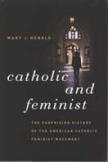Not an Oxymoron
Reading Catholic and Feminist has been a strange experience. The book centers on the years between 1960 and 1980, a two-decade slice of American Catholicism as lived by women (and a few men) trying to be true to their faith and their feminism. The strangeness I felt stems from my coming of age during these years, following a similar life trajectory, and now reading about it.
The book has eight chapters, an introduction, epilogue and extensive footnotes. There are lists of oral history interviews, primary and secondary sources and archival materials. Perhaps most intriguing are the many pictures scattered throughout the text that give it the feel of a family photo album. While these features are helpful to any reader, they are invaluable if the book is adopted for courses, study groups or book clubs.
Catholic and Feminist is an example of feminist scholarship that deserves the name: professional yet personal, documenting assertions without hedging and offering a vision that balances the real and the ideal. The author, Mary J. Henold, is an assistant professor of history at Roanoke College; her scholarship is careful, her writing style clean.
Refuting the possibility that Catholic feminism is an oxymoron, Henold as a historian simply lays out the record of its origins, development, major participants and significance. She marks the year 1963—when a number of Catholic women published articles that clearly expressed feminist sentiments—as the beginning of “second-wave” Catholic feminism. Betty Friedan’s The Feminine Mystique and the civil rights movement were capturing attention. Still, Henold shows that neither was the primary impetus for the Catholic feminist movement. That distinction belongs to the Second Vatican Council.
The irony of Catholic feminism’s origin is both appropriate and painful to feminists of faith: the movement was not merely an “add-on” to the culture; it was internally generated by the promise of the church to be the “people of God.” The council gave Catholics hope that the church could and would change: become responsive to local and national concerns, embrace collegiality and welcome the laity—especially women—into its sanctuary. When that promise went unfulfilled, the faith of feminists was shaken and many felt betrayed.
Chapter 1, “Origins,” reviews the works of two earlier “Catholic Action” organizations (founded in the 1940s). These are The Grail, which groomed single women as “lay apostles,” and the Christian Family Movement, which urged middle-class married couples to commit their families and communities to Christ. Both continue to foster lay leadership and spiritual growth, though neither was feminist initially. A more direct feminist connection is found in the Sister Formation Conference, established in 1954 to promote the education and professional status of women religious. These “new nuns” were highly influential in Catholic feminist circles. Identified or not, the enemy that both lay and religious women faced was the entrenched image of the Eternal Woman, the portrayal of women’s nature as pious, pure, self-sacrificing, submissive to (male) authority and focused on motherhood (real or spiritual). The model was Mary, virgin and mother.
Chapter 2, “Demythologizing Our-selves,” cites the writings of more than three dozen Catholic women who debunk the myth of the Eternal Woman. Mary Daly, Rosemary Radford Reuther and Sidney Callahan are highlighted. Common themes include an insistence in their writings on women as unique, self-critical and searching; the same requirement for both sexes to become mature Christians; and the need for the church to abandon its misogyny. Catholic feminists linked feminism to church renewal; their feminism was an expression of a faith that does justice. Another painful irony: 1968 saw the publication of both Mary Daly’s The Church and the Second Sex and Pope Paul VI’s Humanae Vitae.
Chapters 3 and 4 are paired, exploring different ideological approaches. The first, titled “No Cakes in Hands Unless Ideas in Heads,” deals with radical feminism, whose leaders brought the organization much creative energy but who were unwilling to work within an institutional church they felt was irredeemably sexist. By the mid-70s they had left. “The Spirit Moving” captures the stories of women who declared, “We are feminists BECAUSE we are Catholic.” Lay and religious, they rooted their feminism in Catholic social justice teachings and a sacramentally celebrated spirituality.
The four chapters that follow enact the morality/passion play that still continues. Chapter 5, “The Love of Christ Leaves Us No Choice,” focuses on the first national Women’s Ordination Conference (1975). Chapters 6 and 7 pursue the strategies that marked the movement in the mid- to late 70s. Their titles encapsulate their content: “Making Feminism Holy”—using liturgy to heal personally and communally—and “A Matter of Conversion”—using dialogue, especially with local bishops, to renew (and reform) the church. Despite these strategies, in 1978 the occasion of the second Women’s Ordination Conference revealed divisions within the movement. Chapter 8, “Sustained Ambivalence,” treats respectfully the various choices Catholic feminists faced (and face). Here, perhaps, the choices are epitomized by two women. Theresa Kane was the nun whose public words to Pope John Paul II in 1979 registered the loyal opposition’s speaking the truth to the pope. A short time later Rosalie Muschal-Reinhardt, a leader long committed to dialogue and church renewal, decided she would no longer struggle with the institution, choosing instead to work for change from the margins. The examples of both women should strengthen Catholic feminists whose sustained ambivalence may yet save our sinful church.
This article also appeared in print, under the headline “Not an Oxymoron,” in the November 3, 2008, issue.








